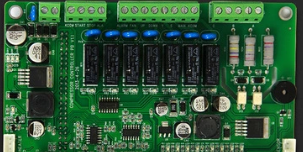The manufacturing process of general electronic products is divided into two parts: PCBA and Box Build. Some factories only do the circuit board assembly (PCBA) part, and then send it to another factory for finished product assembly (Box Build) after completion, and some factories from start to finish, the manufacturing process is as follows:
SMT manufacturing process:
1. PCB Loading: Usually, the PCB is manually put into the Magazine Rack (material rack) to facilitate automatic feeding production.
SMT magazine rack ← SMT magazine rack
2. Glue dispense ─: It seems that it is only used in early circuit boards and requires the "wave soldering" process. Glue is dispensed under the electronic parts, and the purpose is to stick the electronic parts on the circuit board after temperature baking, so as to prevent the electronic parts from falling into the tin furnace through wave soldering.
3. Solder paste printing or glue printing (MPM): The solder paste printing or glue printing (MPM) is used to print the solder paste on the circuit board through the stencil. The solder paste is a bridge connecting the PCB and electronic parts.
[SMT] STEP-UP & STEP-DOWN Partial thickening/thinning steel mesh
SMT Steel Mesh
How to choose solder paste (Solder paste selection)
Introduce the basic knowledge of [solder paste]

4. Solder paste inspection: Some factories do not necessarily have a [solder paste inspection] process, the main purpose of which is to check the problematic solder paste printing before the part is mounted, such as whether it is offset, the amount of solder paste Is it enough to wait, and then eliminate or correct the solder paste printing that may cause poor soldering.
5. Pick & Place:
Fast machine ─ small parts (such as resistors, capacitors, inductors) (small chip)
Slow speed machine ─ general purpose machine, large parts (such as IC, connector)
Special-shaped machine ─ basically suitable for clamping, you can also hit the parts on the tray
Hand ornaments ─ If all the machines cannot be hit, place them by hand at the end (not recommended)
SMT related articles:
Pallet packaging tape and reel packaging
Comparison of the advantages and disadvantages of Tray and Tape-on-reel packaging in SMT
[Technology] Red Dye Penetration Test
[SMT] Matte tin, Bright tin
5. Reflow: see another article Reflow Profile
6. Auto Optical Inspector (AOI, Auto Optical Inspector): optically inspect whether there are wrong parts, dropped parts, offset, poor tin, insufficient tin, short-circuit of solder, and occurrence of solder balls. It is difficult to check for empty solder and false weld.
7. Hand soldering parts: There are some electronic parts that cannot be made with existing SMT machines. If there are a small number of parts, they will use [hand soldering] parts; if there are more, they will consider using [wave soldering (wave soldering). )】Process.
8. Receiving and visual inspection of appearance: The PCB will automatically enter the Magazine Rack (material rack) when receiving the board, the purpose is to prevent the electronic parts from colliding each other
PCBA test
9. PCBA de-panel:
V-Cut: folded edge
Router: similar to washing the bed and removing the board edge
10. PCBA test:
MDA/ICT
PCBA function test (Function test)
Steps 9 and 10 can be interchanged according to process requirements.
Finished product assembly (Box Build)
11. Finished product assembly (Box Build)
12. Burn-in test (Burn/In)
Discussion on the advantages and disadvantages of product aging test (Burn/In)
13. Final Test
14. Ship to stock